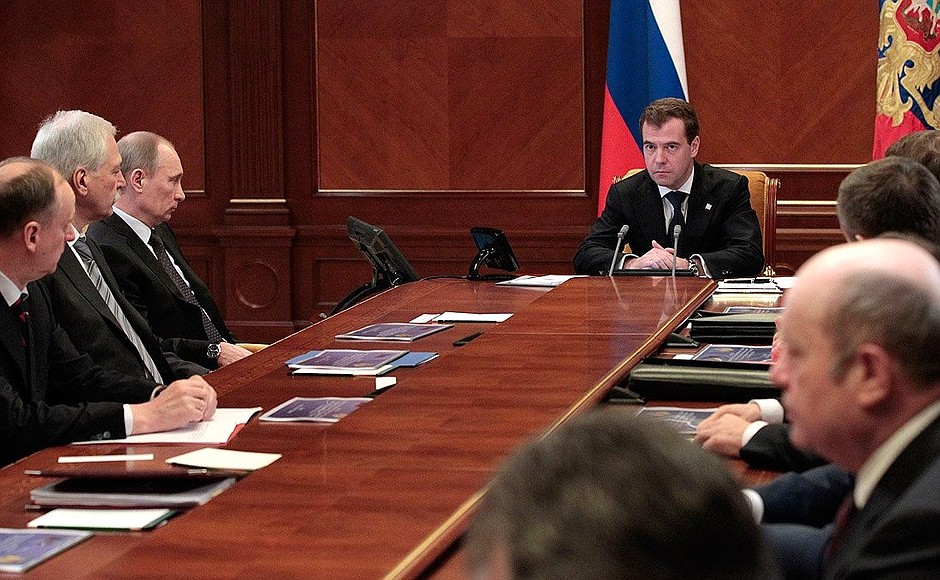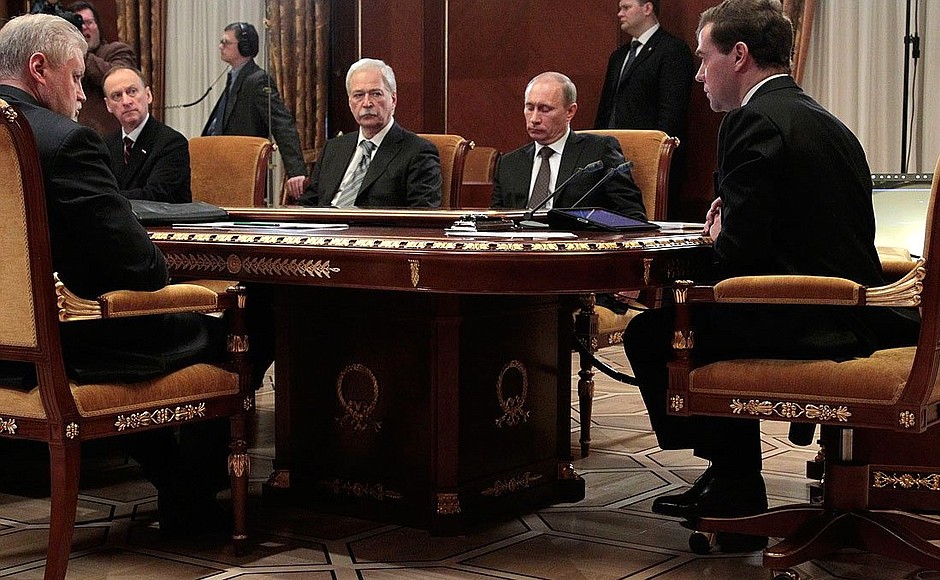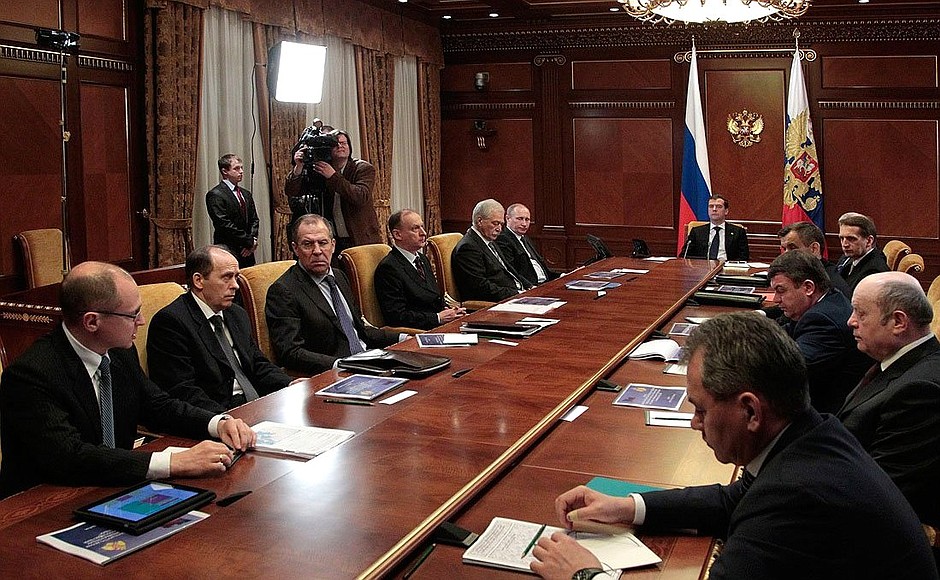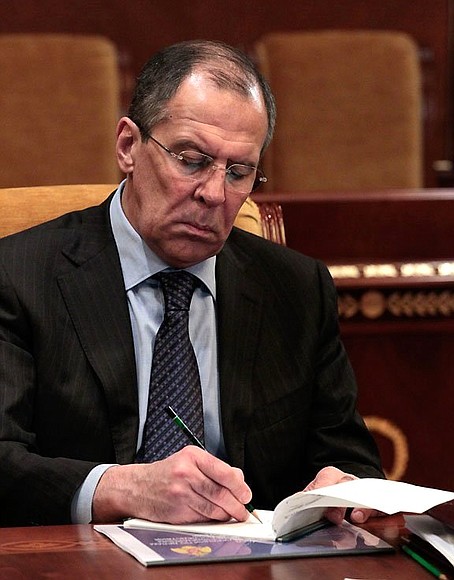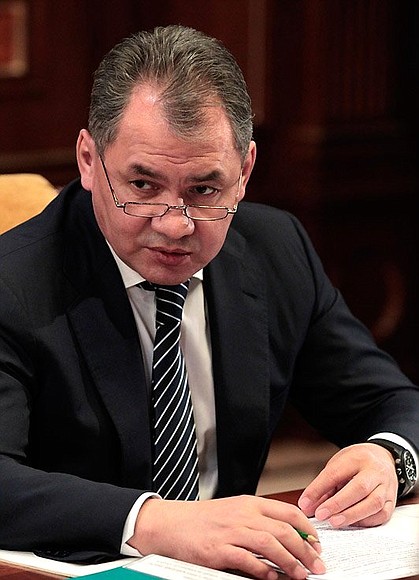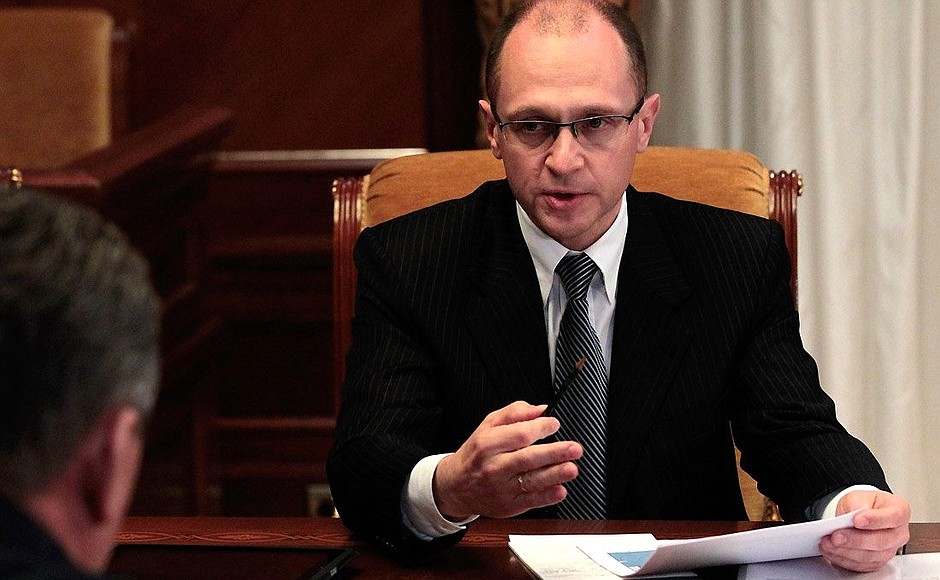* * *
President of Russia Dmitry Medvedev: We have had to devote a lot of time to unusual weather, extreme situations, and various accidents over the last years. But this is one of the authorities’ duties of course, because such disasters and accidents often cause huge material damage and, sadly, loss of life.
The earthquake in Japan has already claimed more than 16,000 lives, and the toll continues to rise. This disaster shows us just how important are international efforts and programmes to help deal with natural disasters, which unfortunately we cannot predict or prevent.
I have already ordered that rescuers be sent to Japan, and they are working there now. We are also ready to provide our Japanese neighbours and colleagues with humanitarian aid, send foodstuffs, water, medicines, any other goods required. The Cabinet is dealing with this. We also need to look at the possibility of bringing groups of Japanese children and disaster victims in general to our sanatoriums, where they could receive medical treatment and psychological rehabilitation. We could also look overall at the possibilities if need be for perhaps making use of some of our neighbours’ labour force potential, especially in sparsely populated parts of Siberia and the Far East. This could benefit our country, and at the same time it could be one means of helping out our neighbours in this very difficult situation.
We are also ready to send to Japan brigades of experts with experience in collecting and analysing information on the radiation situation, and environmental and medical data. They could help out with drawing up recommendations on the priority areas and protection measures for protecting personnel and local people against radiation, and if necessary, on medical assistance.
Coming to what we are doing now and what further steps will be needed, the Emergency Situations Ministry will need to keep monitoring the situation in the Far East, monitor the radiation situation, working together in close coordination with the Russian weather service’s regional offices and our consumer protection services, and keeping watch over developments in the geophysical situation. The Russian Academy of Sciences can be engaged in this work too. Of course, this work will also require coordination with the Defence Ministry’s Eastern Military District too. All additional measures must be taken to protect the population from possible consequences of the earthquake in Japan. I know that Mr Putin is flying to the Far East, and so the Government should check out the overall situation in the region and make sure that our people there have all the needed supplies of medicines and protection and monitoring supplies. This is important because the situation at the Japanese nuclear facilities continues to develop. We need to monitor these develops calmly and plan protection measures that may be needed, and ensure too of course that our people are receiving accurate and up to date information on the radiation situation and what the authorities are doing and can do to protect them.
We need to learn from what has happened and once again evaluate the means we have for monitoring the radiation situation. This is all the more important as we are ourselves carrying out a large-scale programme to build and operate nuclear power plants. We are sure that they are effective and safe, but we always need to have a monitoring system and action plans in place just in case, because no one is insured against natural disasters of course.
We also need to do some summing up and make some conclusions following last year’s heat wave. I issued some instructions last summer and autumn regarding improvements to the forest legislation and putting in place more effective disaster management mechanisms. I also gave instructions on re-equipping the fire and rescue services, developing the insurance system, and raising people’s environmental awareness. The Russian [Federal Forest Service] Rosleskhoz was made directly subordinate to the Government in order to improve control and supervision in this area, and the necessary amendments were made to the Forestry Code. More than 300 fire engines were sent to the regions. Today we will hear a report on what is being done to establish specialised regional commissions in this area, so that our services do not find themselves unprepared should similar events occur again this summer. Of course, we also need to make use of preventive measures. I want to hear about all of this in the report today, but we will first hear the latest updates on the situation in Japan regarding the earthquake, tsunami, and the technological disasters there.
There is one other issue I wanted to mention. The UN Security Council has passed another resolution on Libya, this time concerning a no-fly zone and possible military operations. Our country abstained on the voting. The resolution was passed, and clearly a number of countries might begin taking action very soon. We need to discuss this matter immediately, think about the safety of our diplomatic staff still in Libya, and discuss the situation in general. I want to hear the Foreign Ministry’s proposals.
Now, I would like the Emergency Situations Minister and the Head of Rosatom to say a few words. Mr Shoigu, please go ahead.
Minister of Civil Defence, Emergencies and Disaster Relief Sergei Shoigu: Thank you. Mr President, colleagues,
From the beginning, we have set up the federal operations headquarters. It is working around the clock, and the necessary departments that can be engaged in resolving the situation in Japan are working there.
We have formed a rescue team in Sendai made up of Russia’s Emergencies Ministry staff: 161 people, seven units of equipment. They have searched over 18 square kilometres. Unfortunately, we have not found any living so far. The time and weather are not favourable. We have found 66 victims. The operation is using seven aircraft and freight ships are shuttling humanitarian aid. Passenger ships are providing support to evacuate citizens. A heavy Mi-26 helicopter is on standby at the port in Narita in case we need emergency evacuations for the rescue teams.
In the last 24 hours, many of our citizens have arrived from Japan to the city of Khabarovsk – 57 people arrived on unplanned emergency flights. Today, we are evacuating Moscow’s Nikulin Circus. We have begun the gradual evacuation of 800 Russian citizens from the Narita airport. Five flights are planned for today: three to Khabarovsk and two to Vladivostok. We have added cars, higher-capacity planes…
Dmitry Medvedev: Mr Shoigu, are there any assessments of the overall number of Russian citizens and natives of our country that would like to leave at this time? Is there any information?
Sergei Shoigu: According to the Foreign Ministry, there can be up to 6,000 of such citizens. But only 2,000 people are officially registered.
Dmitry Medvedev: I see.
Sergei Shoigu: Two thousand are officially registered. I think that this number will increase.
Sergei Lavrov: Just yesterday, it was one thousand.
Sergei Shoigu: Yes, because in just the last few days, 1,936 people left by regular flights. In other words, if we are talking about registered citizens, that’s nearly everyone. But the figure will certainly increase.
We continue to provide humanitarian aid: this includes warm clothes, blankets and bedding. And in addition to everything else, we have offered our hospitals, through the Foreign Ministry – Mr Lavrov discussed this with his Japanese colleague in Paris. Among other things, we also offered the list of things we just mentioned, like medicine and food.
Drinking water is a special issue. That is precisely why we offered our Japanese colleagues water filtration systems, in order to ensure adequate access to drinking water. Today, water represents a major, serious deficit.
The overall situation is that we currently have 399 monitoring posts. There are joint posts. They have been arranged on vehicles of the FSB border patrol, the Coast Guard, Defence Ministry, Emergency Situations Ministry, and Hydrometeorology and Environmental Monitoring Service. We have 24-hour monitoring in the Far Eastern Federal District, and extra monitoring is being done every two hours – another 265 monitoring posts in Khabarovsk, Primorye and Kamchatka Territories, and Sakhalin Region. Five aircraft and 18 ships are engaged in radiation monitoring. They have not registered any increase in radiation levels, and I think there will not be any, but I expect that Mr Kiriyenko will speak about that.
What else has been done and prepared? In the last three days, we have had three seismic events on Russia’s territory, including a 5.0-magnitude earthquake in Amur Region, a 3.9-magnitude earthquake today in Baikal, and an earthquake yesterday in Kamchatka or off the coast of Kamchatka, which did not cause a tsunami. I would like to note that the tsunami early warning system that has been created (we created it following the devastating earthquake in Southeast Asia on Mr Putin’s instructions, together with the Hydrometeorology and Environmental Monitoring Service and the Russian Academy of Sciences) worked quite effectively in all of these cases, and we simultaneously alerted more than 11 thousand people who, having received the warning, were able to evacuate.
In order to react to possible seismic events, we have formed a task force in the Far East consisting of 4,300 people and 851 units of equipment. Constant increased monitoring is being done engaging 638 people and 260 units of equipment. Overall, we have a combined task force for Kamchatka and the Kuril Islands that is part of the national emergency alert and action system, which includes the Defence Ministry, aviation, and disaster medicine. It has been formed and includes 11,400 people and 2,700 units of equipment. In accordance with the Volcano plan, all systems have functioned normally. As to the rest, we are doing planned work and planned monitoring and situation control, and continue to carry out the operation.
With regard to your instructions concerning Japan, we have finished work on main sites in the city of Sendai, and are currently relocating to new sites closer to Narito, east of Fukushima.
Dmitry Medvedev: Mr Shoigu, I gave you and other departments instructions to improve provision of information to the public. Has this been done?
Sergei Shoigu: We currently inform the public through the media. All media are engaged in this, including electronic media and radio stations. Every 15 minutes, radio stations that broadcast the news are giving out information about radiation levels. In addition, we have activated the KSION (the comprehensive public alert) system, which has been completed only partially and is scheduled for final completion by 2015; we have shown you parts of it. In addition to everything else, we have replenished our reserves and together with Healthcare Ministry we have sent additional medicines there as the demand is running on a bank. Naturally, we are trying to calm people down, talk to them, keep them constantly informed to avoid any speculative demand for radiation monitors and iodine-containing medicines; we have set aside 40 tonnes of these products and sent them there on March 15.
Dmitry Medvedev: Mr Kiriyenko, your report please.
Rosatom State Atomic Energy Corporation CEO SERGEI KIRIYENKO: Mr President, members of the Security Council,
We have already reported on the latest developments. It is clear today that the American company that designed the station and the Japanese operating company did not foresee that the power station could be simultaneously hit by an earthquake and a tsunami, and that is the root of the problem. The technology is able to withstand each of these events separately but not both at the same time. After the earthquake, the station continued to work in a normal mode, the emergency system was triggered and the reactors were shut down, but then an hour later the tsunami came, destroying the water feed system of the emergency diesel generators, there was a power failure. I think we can also say that the magnitude of the problem was initially underestimated. The company expected that it would be able to cope on its own and lost the valuable time when the situation could have been altered radically.
Today the situation is severe and continues to deteriorate. Our Japanese colleagues are doing everything they can but the measures they are taking are mostly aimed at halting the pace at which the problem is deteriorating; so far their efforts have not lead to suspending this development, much less to turning it around.
Of the six reactors at the nuclear power plant, three were in operation, and three were undergoing planned maintenance works. The fuel rods inside the reactor body have melted down at all three reactors undergoing maintenance, which means that radioactive gases from the reactors are being emitted into the atmosphere. Efforts to restore the water level have failed. The water level in all active zones is below a critical level. There is a risk that the second reactor has little or no water.
Unfortunately, the situation has deteriorated further. In the past two days water has begun to evaporate in the ponds which store used nuclear fuel from the reactor. This process began at the fourth unit, which was undergoing repairs. There was no fuel in the most active zone, all the fuel was in the cooling pond. Since there is no water inflow, the remaining water began to boil and evaporate; as a result, the fuel rods were exposed to the air, and a reaction was triggered. This largely contributed to the emission of radioactive substances into the atmosphere, since the cooling pond is not located in a sealed area. The reactor is sealed in a protective shell, but the pond is located outside the reactor. Bear in mind that this is an old design, over 40 years old. All the Fukushima reactors were built between 1971 and 1979, they were designed by General Electric, and built by the Japanese.
Radioactive fission began in the cooling pond, which greatly increased the level of radiation at the site. Today, the radiation level at the site is such that it is almost impossible to work, that is, they have to work for very short periods of time, and even then the personnel are exposed to very high doses of radiation. Therefore, a number of jobs that began at the site had to be suspended because there is a risk of overexposure. At the same time, working from a distance does not have much effect. For example, the attempts to drop water from helicopters were abandoned because they had no effect, the helicopters had to remain high above the reactors. Efforts are ongoing, power has been restored, but, unfortunately, not at the time when the radiation level at the site was low. If they had restored electricity at that time, the situation could have been stopped. Today, that chance still remains, but it is diminishing by the hour.
We have set up an analytical centre, which uses mathematical models to predict the possible development of events, and we have looked at the worst-case scenario in our calculations. Unfortunately, our forecasts have proved to be correct so far. There is not enough information, and we have been keeping in touch with our colleagues from outside Japan as well. Two of our experts are presently in Japan but, unfortunately, they were not allowed into the crisis centre; nevertheless, they are in contact with the IAEA mission, the World Association of Nuclear Operators and Japan Atomic Industrial Forum.
Yesterday I contacted my counterpart in the United States, and we agreed to share information; our forecasts are largely the same or very similar. Our teams that make the calculations now share the information in order to predict the situation more accurately. The Americans have more people, they designed the power station and understand it better, but the initial data we have is the same.
We have calculated the worst possible scenario, which is that efforts to reverse the process will fail and the fuel in all the reactors will melt; in the most dramatic case possible, this will happen in all cooling ponds. We have calculated the consequences of such developments.
Our first task was to try to understand whether there is a risk to the territory of the Russian Federation, primarily for the Russian Far East. We have already done multiple calculations, the worst of them with the maximum emission of radioactive substances into the atmosphere if the meltdown occurs in all the reactors and in all the ponds. In addition, we have looked at the most adverse wind direction; what is saving the situation for Japan now is that the wind has been blowing in the direction of the ocean, it has been an easterly wind, from the west to the east, carrying everything towards the Pacific Ocean. But even if we assume that the wind will turn around at the very peak of activity and will blow straight in the direction of the Russian Far East with a high speed, and even if we assume that it will begin to rain when it reaches our territory – that is the absolutely worst, a madly adverse scenario when things cannot get any worse – even then there will be no threat for us. Radiation levels will not only remain below critical, but they will be approximately ten times lower than the permissible level, which requires no protection, no iodine-containing medicines and no evacuation.
Therefore, I can say with absolute confidence that the only risk we have today in the Far East is the psychological effect the situation is having on the local residents. Because the only thing that can threaten their health is if they get so scared they give their kids or take themselves huge doses of iodine-containing medicines. That's the only threat to the people’s health in the Russian Far East.
I would like to add that the Emergency Situations Ministry has done a very useful thing: in addition to everything the Minister has mentioned in his report, they are also posting the radiation levels data they get from the automated radiation monitoring system on their website.
Dmitry Medvedev: In real time.
Sergei Kiriyenko: Yes, in real time. We also have this data at our facilities, but we don’t have many facilities in the Far East, so the Emergency Situations Ministry is posting the data in their system. That is very useful because people cannot wait for the next news broadcast, or if someone has missed the news they can go online and see the data coming in in real time from all the radiation monitoring sensors near them. The level is absolutely stable, and I repeat, there is no reason to believe that a significant threat may arise.
In conclusion, I would like to report that we have instructions from Mr Putin to conduct a comprehensive inspection of all nuclear power stations in the Russian Federation. We have already started this work together with the Energy Ministry, the Natural Resources Ministry and the Federal Service for Environmental, Technological and Nuclear Supervision. We are checking emergency response systems at all operational nuclear power stations, their ability to handle various adverse factors such as power cuts and the entire range of hypothetical external factors.
In addition, we are conducting an audit of all nuclear power station construction projects in Russia and around the world. We have no nuclear power stations or plans to build them at such high seismic risk locations in the Russian Federation. In fact, this is forbidden by Russian legislation. That is, the law prohibits building nuclear facilities at the sites where seismic activity risk is 8 points or higher. The maximum level allowed is 6, and the stations we have at such locations have an 8-point security level, meaning that we go for a double safety margin.
Nevertheless, we are now conducting a comprehensive audit of all our nuclear power station construction projects and analysing what improvements can be made to these projects in view of the emergency response efforts at Fukushima.
Dmitry Medvedev: In any case, we must get ready for the long haul because after the accident at the Chernobyl station, where everything happened very quickly, the consequences were felt throughout the world for quite a long time and in a variety of locations.
Of course, this is no reason to whip up hysteria. On the contrary, it is vital to stop the panic, because there is no reason for it, as you've just reported. But it is important to monitor the situation, especially since the events at the station are continuing to develop, the process is very complex and it is likely that it might have a tragic outcome, which you have mentioned in your report.
A few things we must consider internationally: it is already clear that the existing international legal framework, the conventions on security in such cases, is not sufficient, both in terms of consolidating international efforts, and taking action to prevent such situations from developing. By the way, you mentioned one example of such legal mechanisms: our domestic legislation does not permit such construction, making it impossible to build in zones with high seismic risk. In other countries it is permitted, in which case it may be necessary to review technological standards, to build power stations with a high security levels, even if it leads to raising construction costs.
But this issue is for the whole humanity to consider, it is not a matter for just one country. I think we should submit relevant proposals together with the Foreign Ministry, the Justice Ministry and in cooperation with other agencies. First, our nation experienced a great deal of suffering following the Chernobyl accident, a tragic anniversary of that event will take place in just one month and our Ukrainian colleagues have proposed a number of initiatives. Second, it is simply our duty as a state that pays special attention to nuclear energy. We believe that despite all the problems, nuclear power is one of humanity’s most important achievements and the backbone for the development of energy cooperation in the future.
<…>
